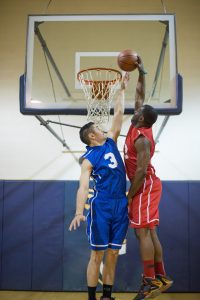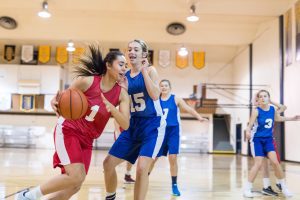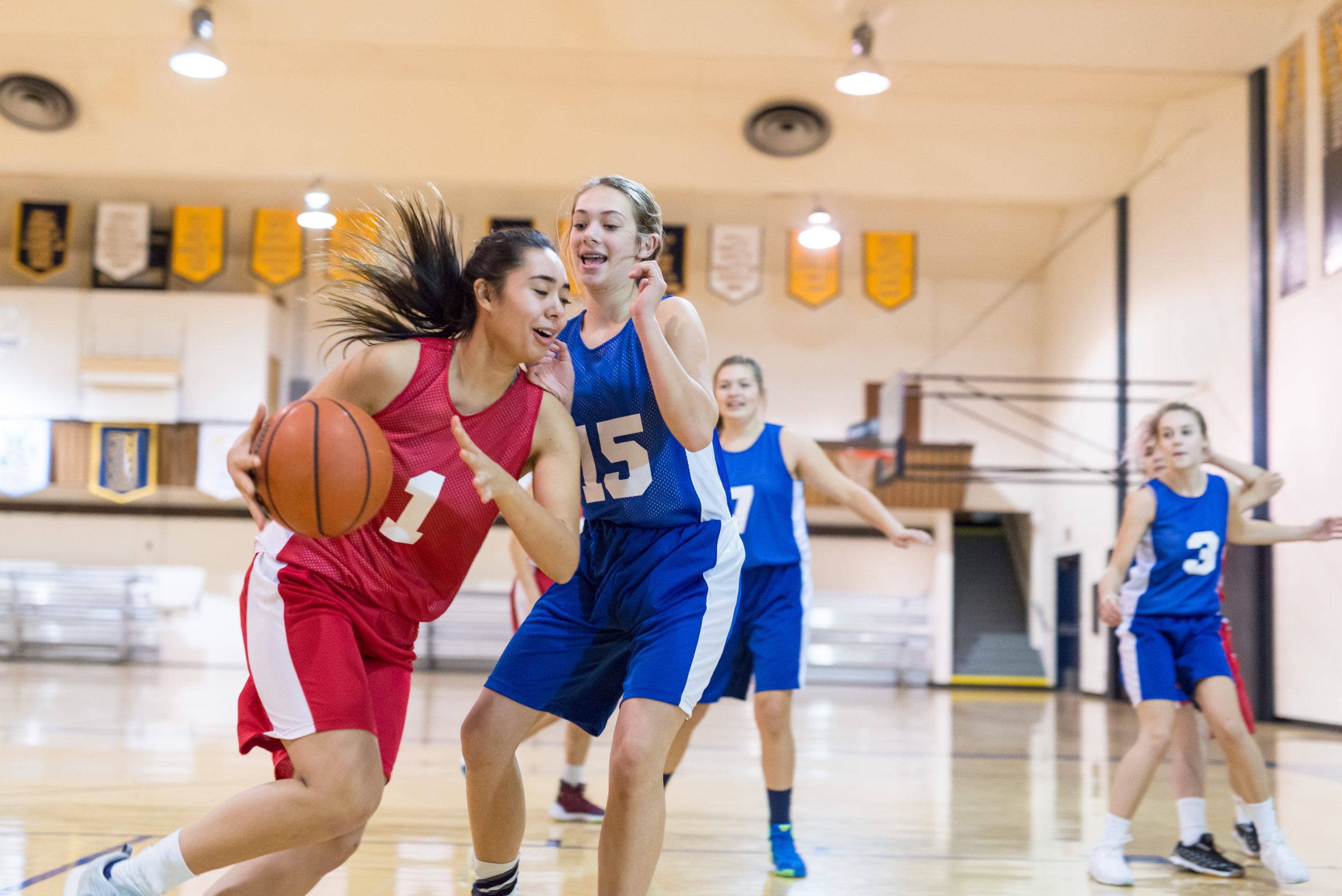Written by Mark E. Rogers, M.D., of OrthoAlabama Spine & Sports
Basketball demands precision, agility, and teamwork. For players throughout Alabama, the basketball season can be both thrilling and physically demanding. As a fellowship-trained sports medicine surgeon with many years of experience, I understand the significance of preventing and managing injuries, especially in young athletes. For players, coaches, and parents of players, it’s important to know the most common basketball injuries — ACL injuries, sprained ankles, and shin splints — as well as what they involve, how to handle them when they occur, and how to prevent them.

High school basketball player dunking
ACL Injuries
The knee joint is a marvel of engineering, but it’s also vulnerable to injuries, particularly the ACL (anterior cruciate ligament). The ACL is a ligament that stabilizes the knee, preventing it from excessive forward movement. In basketball, sudden stops, pivots and jumps can lead to ACL tears. When a player lands awkwardly after a jump or suddenly changes direction, the ACL can be stretched or torn, causing significant pain and instability.
What to Do:
- If an ACL injury is suspected, immediate medical attention is vital.
- The R.I.C.E method (rest, ice, compression, elevation) should be followed to reduce swelling and pain.
- Physical therapy is usually recommended to regain strength and stability.
Prevention:
- Engage in regular strength and conditioning exercises that focus on the lower body, emphasizing proper landing techniques, and practice agility drills.
- Wearing properly fitting shoes that provide ankle and arch support can also help reduce the risk.
Sprained Ankles
Ankles are intricate structures comprised of ligaments that provide stability. When a player lands on an opponent’s foot or twists the ankle during rapid movements, the ligaments can be stretched or torn, resulting in a sprain. The severity of a sprain varies, but it often leads to swelling, pain and difficulty in weight-bearing.
What to Do:
- Initially, the R.I.C.E. method is effective.
- For mild sprains, rest and proper rehabilitation exercises can aid recovery.
- Severe sprains may require immobilization and physical therapy.
Prevention:
- Strengthening ankle muscles through exercises like resistance band workouts, balancing exercises and proprioception training can enhance stability.
- Wearing high-top basketball shoes with good ankle support and taping or bracing the ankles can also minimize the risk of sprains.
Shin Splints
Shin splints, medically known as medial tibial stress syndrome, occur due to stress on the shinbone and the tissues attaching the shinbone to surrounding muscles. In basketball, the repetitive impact of running and jumping can cause irritation and inflammation along the shinbone, resulting in sharp pain. Factors such as improper footwear, overuse, and poor running techniques contribute to this condition.
What to Do:
- Rest, ice, and proper stretching can alleviate shin splint pain.
- Compression sleeves and orthotic shoe inserts can provide support.
Prevention:
- Gradually increasing the intensity and duration of workouts can help prevent shin splints.
- Additionally, wearing appropriate footwear designed for basketball and ensuring proper running techniques can significantly reduce the risk.
Jumper’s Knee
Jumper’s knee, also known as patellar tendinitis, involves the inflammation of the patellar tendon, the thick band of tissue that connects the kneecap to the shinbone. This injury often plagues athletes who engage in frequent jumping, such as basketball players. The repetitive stress from jumping and landing can strain the tendon, causing pain and swelling just below the kneecap.
What to Do:
- Rest the affected knee and apply ice for 15 to 20 minutes every 2 to 3 hours to reduce swelling and pain.
- Use a compression bandage to control swelling, and elevate the leg above the heart level to further reduce discomfort.
- Consult a physical therapist for tailored exercises that strengthen muscles and improve flexibility to aid in recovery and prevent future occurrences.
Prevention:
- Strengthening the quadriceps, hamstrings and calf muscles through exercises like squats, lunges and calf raises can distribute the stress more evenly across the knee joint.
- Additionally, incorporating exercises where the muscles lengthen under tension can specifically target the patellar tendon, making it more resilient to the demands of the game.

An ethnic female player dribbles through the lane and tries to score. A defensive player is stepping up and trying to get there in time to prevent her from scoring. There are pennants and banners in the background.
Achilles Tendon Injuries
The Achilles tendon, the largest tendon in the human body, connects the calf muscles to the heel bone. It is crucial for various movements, including jumping, running, and even standing on tiptoes. In basketball, sudden acceleration, deceleration, or improper landing after a jump can strain or rupture the Achilles tendon, leading to sharp pain and hindrance in movement.
What to Do:
- Rest the leg, apply ice, use compression bandages, and elevate the leg above the heart level.
- Engage in physical therapy for specific exercises that strengthen calf muscles and the Achilles tendon. Regular stretching exercises improve flexibility and support healing.
- Consider custom orthotic devices like shoe inserts to provide additional support and reduce stress on the Achilles tendon.
Prevention
- Regularly stretching the calf muscles and Achilles tendon before and after games can improve their elasticity, reducing the risk of strain.
- Incorporating specific calf-strengthening exercises, such as heel drops and toe taps, can enhance the tendon’s endurance, making it more resistant to sudden forces during gameplay.
General Tips for Injury Prevention
Warm up and Cool Down:
Proper warm-up exercises increase blood flow to the muscles, making them more flexible and less prone to injury. Cooling down with stretching can enhance flexibility and reduce muscle soreness.
Stay Hydrated and Well-Nourished:
Proper hydration and nutrition are essential for overall body function and injury prevention. Dehydration can lead to muscle cramps and fatigue, increasing the risk of injuries.
Listen to Your Body: Pay attention to any signs of discomfort or pain. If something doesn’t feel right, it’s crucial to rest and seek medical advice if needed. Ignoring minor discomfort can lead to more severe injuries.
Cross-Training:
Engaging in a variety of physical activities can balance muscle development, prevent overuse injuries, and enhance overall athleticism.
Regular Check-Ups:
Athletes should undergo regular health check-ups to monitor their physical condition. This can help identify potential issues early and prevent injuries.
While basketball injuries are common, they are not inevitable. With proper preparation, training and vigilance, basketball players in Alabama can significantly reduce their risk of injury. Remember, prevention is key, but in the event of an injury, seeking timely medical attention and following a structured rehabilitation program are paramount. By combining skillful play with a focus on physical well-being, young athletes can enjoy a fulfilling and injury-free basketball season.
As a sports medicine surgeon, my message to the athletes of Alabama is this: your passion for the game can coexist with your safety. By understanding the intricacies of your body and respecting its limits, you can continue to excel on the court while prioritizing your well-being. Stay mindful, stay prepared and let the spirit of the game thrive in the face of a safer, injury-conscious approach to basketball.








